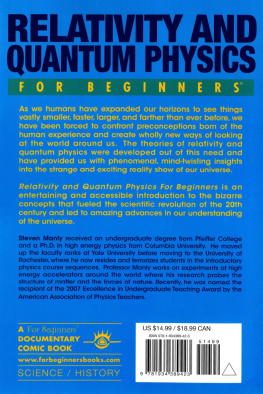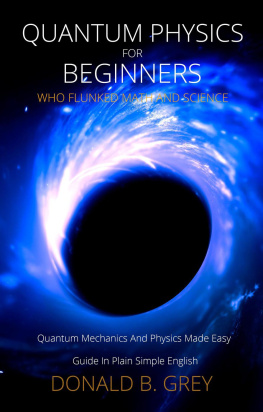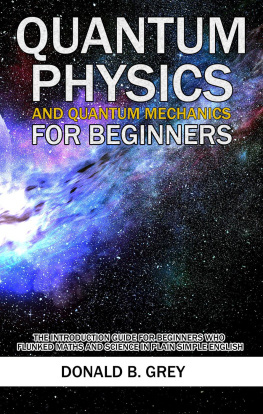Quantum Physics for Beginners
Revealing the Secrets of Quantum Physics by Learning Simple and Useful Notions
Elvin L. Thomas
Copyright 2021 by OLIVER DUNCAN - All rights reserved.
This document is geared towards providing exact and reliable information in regards to the topic and issue covered. The publication is sold with the idea that the publisher is not required to render accounting, officially permitted, or otherwise, qualified services. If advice is necessary, legal or professional, a practiced individual in the profession should be ordered.
- From a Declaration of Principles which was accepted and approved equally by a Committee of the American Bar Association and a Committee of Publishers and Associations.
In no way is it legal to reproduce, duplicate, or transmit any part of this document in either electronic means or in printed format. Recording of this publication is strictly prohibited and any storage of this document is not allowed unless with written permission from the publisher. All rights reserved.
The information provided herein is stated to be truthful and consistent, in that any liability, in terms of inattention or otherwise, by any usage or abuse of any policies, processes, or directions contained within is the solitary and utter responsibility of the recipient reader. Under no circumstances will any legal responsibility or blame be held against the publisher for any reparation, damages, or monetary loss due to the information herein, either directly or indirectly.
Respective authors own all copyrights not held by the publisher.
The information herein is offered for informational purposes solely, and is universal as so. The presentation of the information is without contract or any type of guarantee assurance.
The trademarks that are used are without any consent, and the publication of the trademark is without permission or backing by the trademark owner. All trademarks and brands within this book are for clarifying purposes only and are the owned by the owners themselves, not affiliated with this document.
Table of Contents
Introduction
Thanks to your positive review I can appear among the top positions, and therefore have more visibility. and all this will be your merit.
Thanks in advance
Quantum physics is the field of physics used to deal with submicroscopic entities. Aspects in quantum mechanics are as mysterious and peculiar as aspects of relativity since certain entities are smaller than we can detect freely using our senses and must be viewed with the help of instruments.
Atoms and their substructure are well-known representations of objects that involve a thorough understanding of quantum mechanics. Classical physics theories exist for some of their properties, such as isolated electron shells. We envision isolated "electron clouds" around the nucleus in quantum mechanics.
We are acquainted with certain areas of quantum mechanics. We assume that matter is made up of atoms, the simplest form of an element, which comes together to make molecules, the simplest form of a compound. Although we cannot see single water molecules in a sea, we are mindful that this is due to the sea's large size and a large number of molecules. When we talk about atoms, we usually claim that electrons orbit them in isolated shells around a small nucleus, which is made up of many smaller particles such as protons and neutrons. We also know the electric charge is generated almost completely by protons and electrons in small units. We don't note individual charges in current flowing through a light-bulb as its charges are too tiny and abundant in the macroscopic conditions, just like we don't see individual water molecules in a sea.
Creating Links
Classical physics is a fair approximation of current physics. Quantum physics is appropriate in general and should be used instead of classical physics to define smaller particles, like atoms.
Molecules, atoms, and basic proton and electron charges are all quantized physical entities, meaning they only exist in distinct values and do not exist in all possible values. Continuous is the opposite of quantized. A quarter of an atom, a fraction of a proton's charge, or 14-1/3 cents, for instance, are not possible. Everything is instead made up of integral multiples of these structural elements. Quantum mechanics is a field of physics concerned with tiny particles and the quantification of different entities such as angular momentum and energy. Quantum physics, including classical physics, has many subfields, including mechanics and the analysis of electromagnetic powers. Quantum mechanics resemble classical physics in the classical limit (slow, larger particles), according to the correspondence principle. this book you are about to read is my first job, and to be able to achieve my goal, I need your help.
Chapter 1- What is Quantum Physics?
What is quantum physics, and how does it work? Simply put, physics is the simplest explanation we have of the complexity of the objects that make matter and the forces by which they associate, and it describes how everything happens.
1.1 Getting Familiar
Quantum physics discusses how atoms work, and thus how biology and chemistry work. Quantum physics is needed to understand how electrons travel through a circuit board, how photons of light are converted to current in solar panels or enhance themselves in a laser, or also how the sun continues to burn.
Here is where the challenge and, for enthusiastic physicists, the excitement begins. To start with, no particular quantum theory exists. There are quantum mechanics, the fundamental mathematical mechanism that underpins everything, established by Niels Bohr, Erwin Schrdinger, Werner Heisenberg, and others in the 1920s. It describes basic things like the shift in direction or momentum of an individual particle over time.
Quantum mechanics should be coupled with other aspects of physics, most specifically Albert Einstein's theory of relativity, which describes what occurs as objects travel quickly, to construct quantum field theories, which describe how things function in the physical universe.
Three separate quantum field theories are used to describe three of the four basic forces that interfere with matter: electromagnetism, which describes how atoms keep together; the powerful nuclear force, explaining the structure of the nucleus at the center of the atom; and the weak nuclear force, explaining why certain atoms decay radioactively.
All three hypotheses have been thrown together in shambles known as the "standard model" of particle physics for the last five decades or so. Despite the fact that it seems to be bound together with adhesive tape, this model is the most fully checked portrayal of matter's fundamental workings ever invented. Its grandest success came in 2012 with the detection of the Higgs boson, the particle that provides all other fundamental particles their mass and whose presence had been predicted as far back as 1964 using quantum field theories.
The findings of experimentation at high-energy particle smashers, like CERN's (LHC) Large Hadron Collider, in which the Higgs boson was found, which investigate the matter at its tiniest scales, are well described by conventional quantum field concepts. However and if you'd like to know how things occur in much less abstruse situations how electrons travel or dont travel in solids and so make an object an insulator a metal, or a semiconductor, for instance things get much more complicated.
Image: The Large Hadron Collider (LHC) at CERN.






